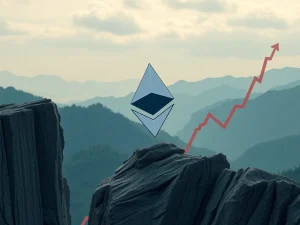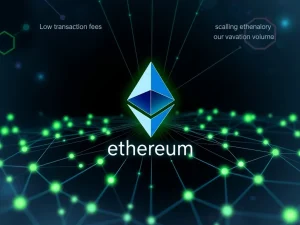Ethereum’s Phenomenal Future: Joe Lubin Predicts 100x Ether Price and Flippening

The cryptocurrency world often buzzes with ambitious forecasts, yet few carry the weight of a prediction from an industry pioneer. Joseph Lubin, co-founder of Ethereum and founder of Consensys, recently made headlines with a truly remarkable statement. He foresees a monumental surge in **Ether price**, predicting it could increase by 100 times its current value. This bold **Joe Lubin prediction** is rooted in the accelerating **Ethereum adoption** by major financial institutions. His vision paints a future where Wall Street fully embraces decentralized rails, leading to a significant shift in the digital asset landscape. Lubin even suggests that Ether could eventually ‘flippen’ Bitcoin as the dominant monetary base. This perspective ignites considerable discussion among investors and market observers, prompting a closer look at the potential for Ethereum’s role in global finance.
Understanding the 100x Ether Price Prediction
Joseph Lubin’s forecast for a 100x increase in **Ether price** stems from a fundamental belief in Ethereum’s capacity to revolutionize traditional finance. He argues that Wall Street institutions, which currently incur substantial costs for their existing infrastructure, will find immense value in Ethereum’s decentralized network. Consequently, these firms will begin to stake Ether, essentially replacing their siloed systems with more efficient and transparent blockchain-based solutions. This shift is not merely about technological upgrade; it represents a paradigm change in how financial services operate.
Lubin highlights several key areas where this transformation will occur:
- Staking: Financial institutions will stake Ether to secure the network and earn yields, replacing traditional revenue streams from proprietary infrastructure.
- Validator Operations: Running Ethereum validators will become a core activity for these firms, ensuring network integrity and participation.
- Layer-2 Networks: Adoption of Layer-2 solutions will provide the scalability and speed necessary for high-volume institutional transactions.
- DeFi Participation: Engaging with decentralized finance (DeFi) protocols will open new avenues for lending, borrowing, and asset management.
- Smart Contracts: Institutions will leverage smart contracts for automating agreements, processes, and financial instruments, increasing efficiency and reducing intermediaries.
These integrations are expected to drive unprecedented demand for Ether, thereby fueling its value appreciation. Lubin’s conviction suggests that the current market valuation of Ether significantly underestimates its future potential, especially as **Wall Street crypto** involvement deepens.
The Flippening: ETH vs. BTC as a Monetary Base
A central tenet of Lubin’s vision is the ‘flippening,’ where Ether’s market capitalization surpasses that of Bitcoin, establishing it as the primary ‘monetary base’ in the crypto ecosystem. This concept, while often discussed, gains new traction with institutional endorsement. Lubin expressed strong alignment with Fundstrat Global Advisors managing partner Tom Lee, who also predicted institutional staking and use of Ethereum could lead to an **ETH flippening**. Currently, Ether’s market capitalization remains a fraction of Bitcoin’s, but its dominance has steadily grown, more than doubling since April to reach approximately 14.3% of the total crypto market.
The argument for an **ETH flippening** is multifaceted:
- Programmability: Ethereum’s smart contract functionality allows for a vast array of applications beyond a simple store of value, making it a foundational layer for new financial systems.
- Utility: Ether serves as gas for transactions, collateral in DeFi, and a staking asset, providing multiple layers of utility that Bitcoin, primarily a store of value, does not offer.
- Institutional Integration: As traditional finance seeks to tokenize assets, issue stablecoins, and build new financial products on blockchain, Ethereum’s robust ecosystem becomes the preferred platform.
While Bitcoin remains a dominant store of value, the increasing utility and programmability of Ethereum, coupled with growing **Wall Street crypto** interest, could accelerate this shift. The market’s perception of Ether is evolving from merely an altcoin to a productive asset and a foundational layer for global financial infrastructure.
Wall Street’s Growing Embrace of Ethereum Adoption
The notion of **Wall Street crypto** adoption is no longer a distant dream but a rapidly unfolding reality. Joseph Lubin’s insights are echoed by other prominent figures in traditional finance. Jan van Eck, CEO of investment firm VanEck, famously dubbed Ether (ETH) “the Wall Street token.” He emphasized that banks must integrate with the Ethereum network to facilitate stablecoin transfers and remain competitive in the evolving financial landscape. This sentiment underscores the critical role Ethereum is poised to play in the future of finance.
The practical implications of this adoption are significant:
- Stablecoin Growth: The stablecoin supply on Ethereum recently surpassed $160 billion, reaching an all-time high and more than doubling since January 2024. This exponential growth highlights Ethereum’s role as the primary settlement layer for digital dollars.
- Tokenization: Institutions are exploring the tokenization of real-world assets (RWAs) on Ethereum, from real estate to equities, unlocking new liquidity and investment opportunities.
- Yield Opportunities: Staking Ether offers attractive yield opportunities for institutional treasuries, making it a productive asset class that outperforms many traditional fixed-income instruments.
These trends indicate that financial giants are not just observing but actively participating in the Ethereum ecosystem. Their involvement validates the network’s security, scalability, and potential for widespread use, contributing directly to the long-term value of **Ether price**.
The Concept of Decentralized Trust and its Value
Joseph Lubin introduces a profound concept: “Trust is a new kind of virtual commodity.” He posits that Ether, as the “highest octane decentralized trust commodity,” will eventually surpass all other commodities on the planet in value. This perspective goes beyond mere technological utility; it delves into the fundamental value proposition of a decentralized, transparent, and immutable system. In an increasingly interconnected and often distrustful world, a robust and verifiable trust layer becomes invaluable.
Nassar Achkar, Chief Strategy Officer at CoinW crypto exchange, supports this view. He notes that institutional clients are increasingly allocating treasury assets to ETH, driven by its staking yield potential and its pivotal role in tokenization ecosystems. Achkar believes that while Bitcoin holds its ground as a store of value, Ethereum’s programmability and Wall Street’s integration with its staking and DeFi rails could significantly accelerate the **ETH flippening**. This transformation positions Ether not just as a digital currency but as the foundational layer for a new global financial infrastructure.
The emergence of a rigorously decentralized economy, powered by hybrid human-machine intelligence on Ethereum Trustware, represents a monumental shift. Lubin believes that the scale and speed of growth in such an economy are currently beyond human comprehension. This long-term outlook underscores the transformative potential of **Ethereum adoption** and its impact on global economic structures.
Market Dynamics and Future Outlook for Ether Price
The market has already shown signs of responding to increased interest in Ethereum. Following Lubin’s remarks and the positive sentiment from other industry leaders, Ether gained over the weekend, briefly approaching the $4,500 level. Although it faced resistance and returned below $4,400 during early trading on Monday morning, the underlying demand and institutional interest remain strong. The exponential growth in stablecoin demand on Ethereum, as reported by Token Terminal, further solidifies its position as a critical layer for digital finance.
As **Wall Street crypto** engagement deepens, several factors could influence the future **Ether price** trajectory:
- Regulatory Clarity: Clearer regulations around staking, DeFi, and digital assets will encourage greater institutional participation.
- Technological Advancements: Continued development of Ethereum’s scalability solutions (e.g., sharding, Layer-2 improvements) will be crucial for handling increased institutional demand.
- Macroeconomic Factors: Broader economic conditions, interest rates, and inflation will continue to play a role in the overall crypto market sentiment.
- Competitive Landscape: While Ethereum is dominant, the emergence of other robust Layer-1 blockchains could introduce new dynamics.
Joseph Lubin’s **Joe Lubin prediction** is a powerful testament to the long-term potential he sees in Ethereum. It highlights a future where decentralized technology is not just an alternative but the very backbone of global finance. The journey to a 100x **Ether price** and an **ETH flippening** is undoubtedly long and complex, yet the confluence of technological innovation, growing utility, and institutional embrace provides a compelling narrative for Ethereum’s continued ascent in the digital economy.
Magazine: XRP ‘cycle target’ is $20, Strategy Bitcoin lawsuit dismissed: Hodler’s Digest, Aug. 24 – 30








